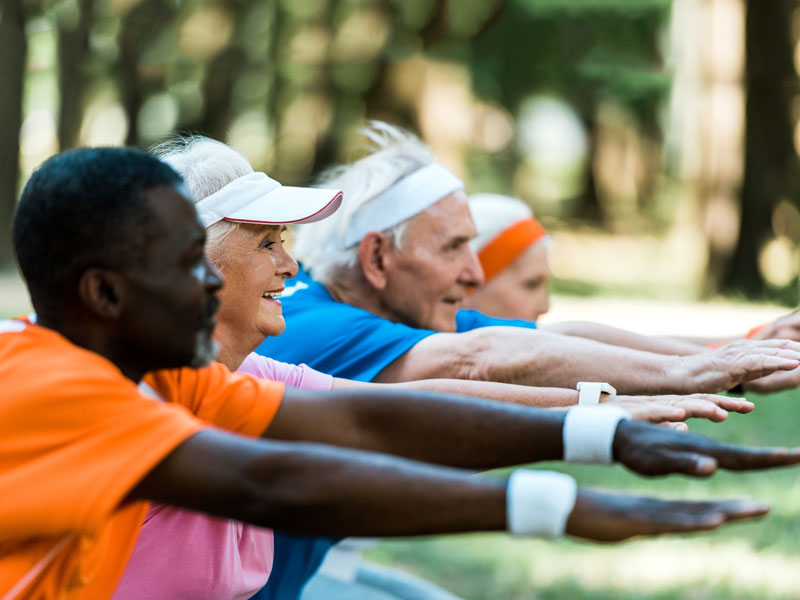Report Gives Strategies to Increase Older Adults’ Physical Activity
July 27, 2023, News Staff — A new report from HHS offers recommendations to improve physical activity levels for people age 65 and older, and AAFP resources can help members implement the strategies.

“The immediate and long-term health benefits of engaging in regular physical activity are well documented. This is why it is so important for all Americans, including older Americans, to stay physically active,” HHS Secretary Xavier Becerra noted in an agency press release, adding, “This report will help us support older adults in living physically active lives.”
The report stems from the 2022 White House Conference on Hunger, Nutrition and Health. It is a companion piece to the Physical Activity Guidelines for America, a federal resource that provides evidence-based guidance to help people as young as 3 years old maintain or improve their health through fitness and physical activity. The new report focuses on older adults — in particular, the amount and types of physical activity older adults need, and suggestions on how and where to perform these activities.
Key Recommendations
The new report recommends that older adults perform:
- at least 150 minutes of moderate-intensity or 75 minutes of vigorous-intensity aerobic physical activity, or an equivalent combination of moderate- and vigorous-intensity aerobic activity a week, preferably spread throughout the week;
- muscle-strengthening activities of moderate or greater intensity that involve all major muscle groups at least two days a week; and
- multicomponent physical activities that include balance training to maintain strength and reduce the risk of falls, such as dancing, water aerobics or tai chi.
The level of effort should be based on their level of fitness. Older adults with chronic conditions understand whether and how those conditions affect their ability to safely perform physical activities, and are encouraged to be as physically active as their abilities and conditions allow.
The report also addresses related topics, including benefits of and barriers to being physically active, and physical and financial costs of inactivity.
Story Highlights
Strategies and Settings
The report suggests evidence-based strategies physicians and others can use to help older adults increase physical activity, with detailed examples of three methods.
- Policy, systems and environmental approaches, geared toward creating safe and easily accessible opportunities at the population level, include configuring neighborhoods to make it easier for older adults to walk, bike or use devices such as wheelchairs, and adding features such as multi-use trails, wide sidewalks and clearly marked crosswalks.
- Behavior change strategies shape individual older adults’ knowledge, skills, attitudes and beliefs about physical activity using cognitive behavioral methods such as raising awareness, setting goals, self-monitoring, social support and physical activity counseling.
- Physical activity program strategies include structured or personalized exercise programs, and programs that raise awareness and encourage older adults to become more physically active in ways that best fit with their current lifestyle.
The report says physical activity interventions have been shown to be successful in health care facilities, homes and community locations such as schools, gyms, libraries and parks.
Call for Collaboration
Less than 15% of older adults currently meet recommendations outlined in the Physical Activity Guidelines, the report says. As such, it is crucial that family physicians and others educate older adults and encourage them to increase their activity levels where possible. Perhaps most important, the report stresses the importance of a multifaceted approach toward a common goal.
“The key is for policymakers; exercise and health professionals; clinicians; gerontologists; built environment professionals; local, state, territorial and tribal leaders; and others working with older adults to partner with one another to plan and implement strategies for connecting older adults where they live to destinations where they can access safe opportunities to be physically active — as well as motivate them to engage in physical activity,” the report states. “Together, we can all help older adults be physically active in a variety of settings and connect the to programs, places and environments where being physically active is the easy and enjoyable choice.”
Plenty of AAFP Resources for Members
There is never a bad time to improve one’s health and well-being, and the Academy has plenty of resources to help members educate older adults about the benefits of being physically active.
In April, the AAFP launched an on-demand lifestyle medicine CME activity to help clinicians guide patients with or at risk for developing chronic diseases and conditions. The activity contains sessions on exercise, nutrition, mindfulness and related topics, all with the goal of effecting positive lifestyle changes.
The Academy also recently unveiled an online obesity CME course, which addresses topics such as weight bias, nutrition, the prevention of chronic conditions and movement in medicine.
And in October, the AAFP will hold a geriatric medicine live course at the Hyatt Regency Coconut Point Resort and Spa in Bonita Springs, Fla., with sessions on movement and physical activity, as well as related topics such as hypertension and osteoporosis management.
Members are also encouraged to share patient-centered resources available on familydoctor.org addressing exercise and seniors and healthy habits for older adults, along with the AFP by Topic collection on geriatric care and an FP Essentials monograph on geriatric care in the community setting.